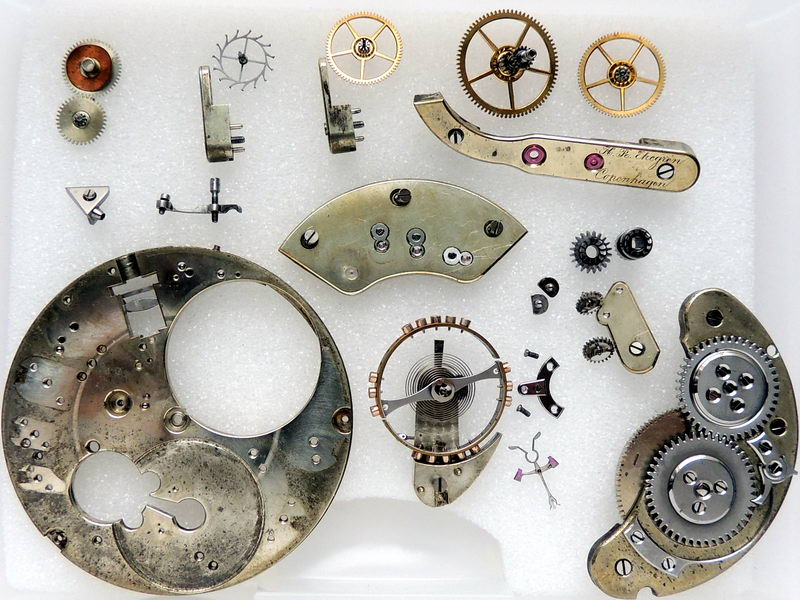А Weekend Job
Last week I re-cased a homeless pocket watch movement made in the 1880’s by famous Danish watchmaker Henri-Robert Ekegren from Copenhagen. H.R. Ekegren worked for top horological companies Jules Jurgensen, Winnerl Paris, Golay Geneva, etc. In 1891 the Ekegren manufacturer was taken over by Edouard Koehn, the director of Patek Philippe. In this way, it became a part of the glorious Patek manufacturing empire.
Some technical details: Original enamel dial, original hands, new custom made stainless steel case – all frontage in perfect condition. Highest grade lever chronometer movement features palladium hairspring, solid gold balance screw weights, ultra fine pallet lever and ‘swan neck’ precision regulator.

The only confusion was about the caseback view. The movement was kept out of a case for a long time, stored for many years in an old watchmaker’s drawer. Small oil and moisture drops have corrupted into visibly dark tarnish spots.
You might ask whether it was previously treated with cleaning powder, and whether it passed all standard procedures in a watch cleaning machine with special cleaning solutions. I can answer you “yes” to all these things. It’s oiled, adjusted and runs perfectly! But these tiny tarnish spots remain, and cause me resentment.

What a pity – a perfectly working movement with an untidy back view. However, it is not dirt or dust. It will not affect the precision of the movement.

These spots are a micro corrosion in the top layer of the metal. Meaning that it can’t be removed with cleaning, and special mechanical treatment will be needed.
Condemned to a Full Refinish
To make a visual improvement, I had to repeat a big part of the work already done to the movement. Firstly, it must be disassembled again and all the clean parts put on a new plastic tray.

All bridges, wheels, screws, and springs must be removed from the mainplate. We need access to a completely naked surface.

A reminder of how the mainplate looks before. Next, I’ll try some methods to improve this view.
First Approach – Hand Rubbing
The first simple method to try, is to rub-off spots with cleaning powder and water. I rub it hard with both my fingers and with cotton swabs. Sometimes this method works well, but here you can still see many traces of corrosion left after the treatment.

It looks a bit better than it did initially, but still not enough for the high-class restoration that we set out to do.

Not everything made by human hands is best, especially when it comes to metalwork. But I had to try this smoother method first, as sometimes it is enough (but not this time).
Invoking the Machinery
To make honest, quality restorations, any watchmaker must operate with a lathe and some other simple machinery. For the next step we will brush the mainplate surface.
Using sandpaper is unacceptable. Pieces treated with sandpaper will not look vintage, but cheaply ground. Also, sandpaper cannot access the recessed balance slot, and so will leave it dirty.
We will process the mainplate with coarse diamond paste and a grinding brush disk. I did try dry brushing, but it did not produce the desired effect, so I decided to add consistent diamond paste to my efforts.

Fix the mainplate in the lathe using a 3-jaw chuck. Put the brush grinding wheel in the hand engraver drill. Turn on both the lathe and the drill, touch the metal mainplate with the grinder and slowly feed the rotating grinder from the centre towards the edge.

The arrows show two simultaneous rotations (spindle and grinder) and the motion from the centre (orange arrow).
Counter rotation of the piece while using the grinding tool will form a charming ‘sunbeam’ pattern, which is achievable using the diamond paste layer. The metal brush itself will not leave lines, but diamond particles will mark it all very finely.

Next, we rinse it extensively with unblended gasoline and wash it again in the cleaning machine. This time it looks much better!

The mainplate now looks almost perfect for it’s 120-years of age. The smooth sunbeam lines are indistinguishable to the naked eye, but they do play spectacularly in the light.
Now We Must Treat Every Part
In contrast with the very shiny mainplate, the other parts look a but dull. I had to spend some time rubbing every bridge with a generic rubber eraser.

Finally, it’s time to assemble it all back together! Wash all bridges in the machine, oil them, and make final adjustments.

Now I’m finally satisfied with the view. The serene, smooth shine of the finish does not attract too much attention, and it looks clean and sufficiently vintage for it’s age.

This watch looks stunning, I hope you think so too =)

Final Notes
The described method is not suitable for gold-plated mainplates. Yellow gold-plated or white silver-plated mainplates can’t be easily repaired by brushing. We can create the same “sunbeam” pattern using a grinding wheel, but after mechanical processing the parts will need new galvanical plating.
The whole operation took about 3 hours. I spent more time composing this review in English, than I did on the actual work =)


